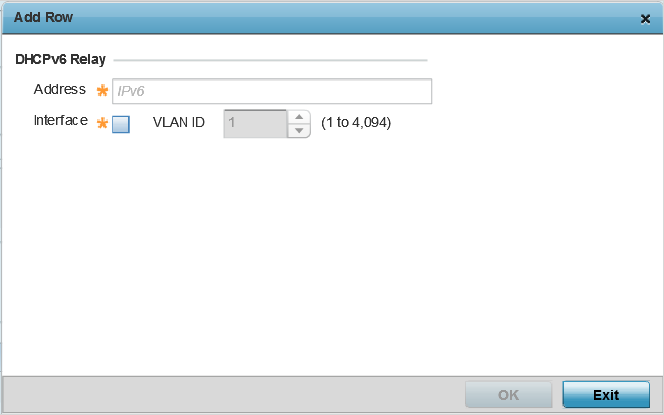To set the selected VLAN interface's IPv6 setting.
The IPv6 configuration screen displays.

|
IPv6 Mode |
Select this option to enable IPv6 support on this virtual interface. IPv6 is disabled by default. |
|
IPv6 Address Static |
Define up to 15 global IPv6 IP addresses that can created statically. IPv6 addresses are represented as eight groups of four hexadecimal digits separated by colons. |
|
IPv6 Address Static using EUI64 |
Optionally, set up to 15 global IPv6 IP addresses (in the EUI-64 format) that can created statically. The IPv6 EUI-64 format address is obtained through a 48-bit MAC address. The MAC is initially separated into two 24- bits, with one being an OUI (Organizationally Unique Identifier) and the other being client specific. A 16-bit 0xFFFE is then inserted between the two 24-bits for the 64-bit EUI address. IEEE has chosen FFFE as a reserved value which can only appear in EUI-64 generated from the an EUI-48 MAC address. |
|
IPv6 Address Link Local |
Provide the IPv6 local link address. IPv6 requires a link local address assigned to every interface the IPv6 protocol is enabled, even when one or more routable addresses are assigned. |
This option is enabled by default.
A new screen is launched. Define the new delegated prefix name and host ID here.

|
Designated Prefix Name |
Enter a 32-character maximum name for the IPv6 address prefix from your provider. |
|
Host ID |
Define the subnet ID, host ID, and prefix length. |
Click Exit to close the screen without saving any updates.
A new screen is launched. Define the new delegated prefix name and host ID can be defined in EUI64 format.

|
Designated Prefix Name |
Enter a 32-character maximum name for the IPv6 prefix from your provider in EUI format. Using EUI64, a host can automatically assign itself a unique 64-bit IPv6 interface identifier without manual configuration or DHCP. |
|
Host ID |
Define the subnet ID and prefix length. |
Click Exit to close the screen without saving any updates.
A new screen is launched. Define the new DHCPv6 relay address and interface VLAN ID here.

The DHCPv6 relay enhances an extended DHCP relay agent by providing support in IPv6. DHCP relays exchange messages between a DHCPv6 server and client. A client and relay agent exist on the same link. When A DHCP request is received from the client, the relay agent creates a relay forward message and sends it to a specified server address. If no addresses are specified, the relay agent forwards the message to all DHCP server relay multicast addresses. The server creates a relay reply and sends it back to the relay agent. The relay agent then sends back the response to the client.
|
Address |
Enter an address for the DHCPv6 relay. These DHCPv6 relay receive messages from DHCPv6 clients and forward them to DHCPv6 servers. The DHCPv6 server sends responses back to the relay, and the relay then sends these responses to the client on the local network. |
|
Interface |
Select to enable a spinner control to define a VLAN ID from 1 - 4,094 used as the virtual interface for the DHCPv6 relay. The interface designation is only required for link local and multicast addresses. A local link address is a locally derived address designed for addressing on a single link for automatic address configuration, neighbor discovery or when no routing resources are available. |
Click Exit to close the screen without saving any updates.